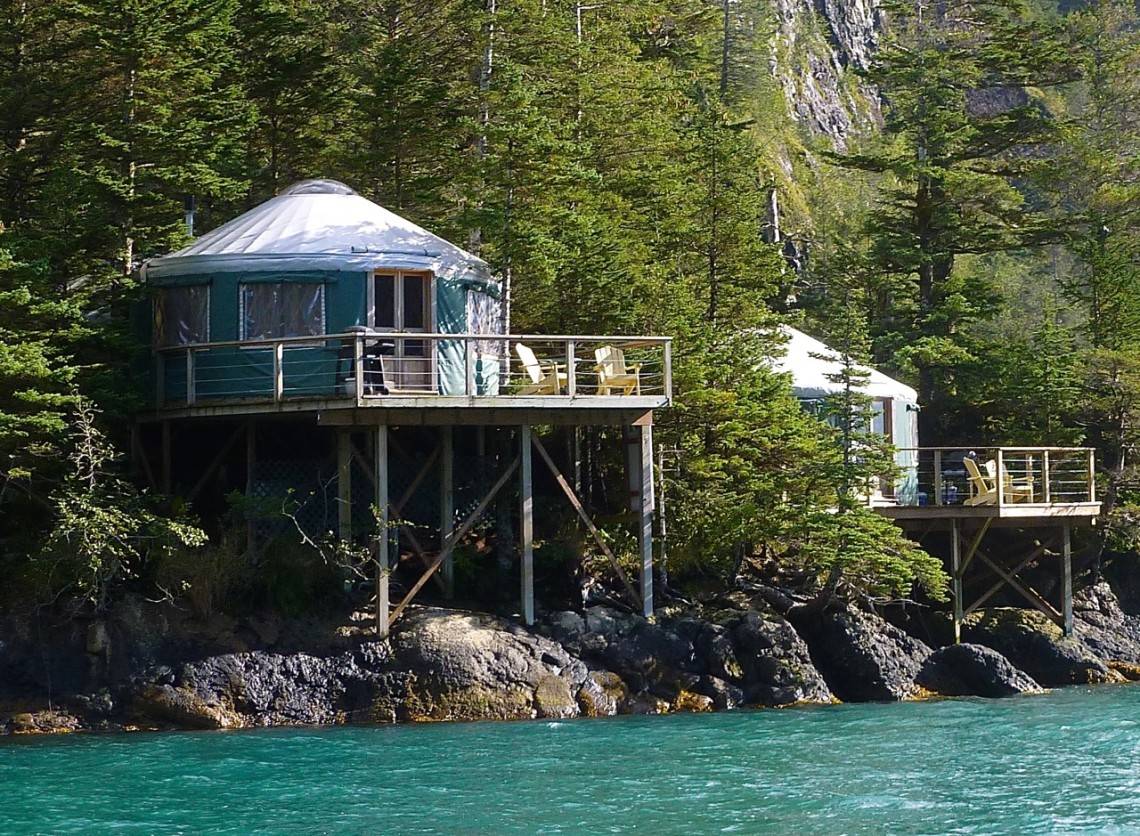Amy George describes glamping as more than just glamorous-camping.
“The way I look at it, is that I still want to go to wild places. I still love to be away from the hotels. I won’t stay at a hotel unless I absolutely have to,” she said. “You’re far enough where you feel like you’re in the backcountry, you definitely see wildlife, you have a full-on experience and you can still be pampered a bit. It’s the comfort.”
Amy just started a glamping operation near Soldotna, it may even be the area’s first. She has two tents, and can accommodate four people. Her first guests arrive this week and their accommodations will be a canvas tent complete with a king-size bed, bedding, a wood stove, private deck, and a flushing toilet and sink. She also has breakfast service available to her guests.
“I made them nice enough where hopefully people are comfortable,” she said.
Glamping can mean different things to different people, but ultimately the goal is to connect travelers with nature, according to Amy Ahlblad, partnerships manager at Glamping Hub, an international online booking platform for alternative and outdoor accommodations.
“[Glamping] is a way in which travelers can stay in the great outdoors without having to sacrifice creature comforts—camping with added luxuries and five-star amenities,” Ahlblad said in an email.
Seeing how well glamping projects in the Lower 48 have done, George, who previously ran a bed and breakfast out of her home, said she always wanted to start her own glamping business on the peninsula.
“I started seeing how huge it was in the Outside, and I thought the tents looked so fun. People like it because they don’t necessarily want to stay in a hotel, but they don’t want to necessarily rough it in Alaska. As I’ve gotten older I’ve appreciated a little more luxury,” George said.
While George is just getting started with her glamping operations in the Soldotna area, a few glamping accommodations have been popular in and around the peninsula for years.
Dennis and Susan Swiderski started Orca Island Cabins back in 2002. The Swiderski’s helped open the original Kenai Fjords Fox Island Lodge, and after they wanted to try something new. Beginning with just one yurt in 2002, Orca Island Cabins turned into a colony of eight yurts, with another one on the way next year. The waterfront yurts are in Humpy Cove, Resurrection Bay.
“We tried the yurts because they are light and airy. They have a minimum footprint, and they’re big enough to have a private bathroom,” Dennis Swiderski said.
The Swiderski’s carry all of the water in from Seward, and the yurts are decked out with solar panels, propane fireplaces and ranges, toilets and showers and queen-size mattresses with bedding. On-site, the Swiderski’s built an art gallery to display his wife’s art for guests to enjoy.
“We kind of started glamping before the concept came up. We chose a certain path and eventually that path became a niche market we got into by accident,” he said.
Across the inlet near Mt. Iliamna, Kent John works with Great Alaska Adventures, helps run a remote glamping experience at their bear camp. John said that they have been offering glamping experiences for over 30 years at Skilak Lake, Thumb Cove in Resurrection Bay, Moose River near the Kenai Wildlife Refuge and now across the inlet at bear camp.
“We decided to invest more in it. We just always liked the tents. It gets people closer to nature, closer to the ground. We want people to see what Alaska is really like,” John said.
At bear camp, guests stay in tents that are equipped with queen or twin-size beds, propane-powered heat and lighting, carpeting, deck and all meals.
Across the Bay Tent and Breakfast sits on the beach of Kasitsna Bay across from Homer. MaryJane Lastufka and her husband Tony, have been offering glamping-style experiences for 25 years. Lastufka said she created Across the Bay Tent and Breakfast to make a beautiful, affordable place for people to stay.
“I wanted people who could handle the tents and outhouses, get back to nature and get the Alaskan experience,” Lastufka said.
While it began with only tents, Lastufka said they have built a couple cabins over the years. All of the tents have carpet, and mattresses, but guests are asked to bring their own sleeping bags if they can. Lastufka grows a garden and offers meals to her guests, as well.
Lastufka said that her accommodations are a little more rustic than most mainstream glamping operations.
“I guess we could call it glamping,” Lastufka said. “Some of those glamping places are way expensive. We are not that high-end, $800-a-night glamping experience, though.”
For people visiting the Kenai Peninsula, finding accommodations to fit their needs and comfort level has never been easier.
These glamping operations are only available seasonally.

